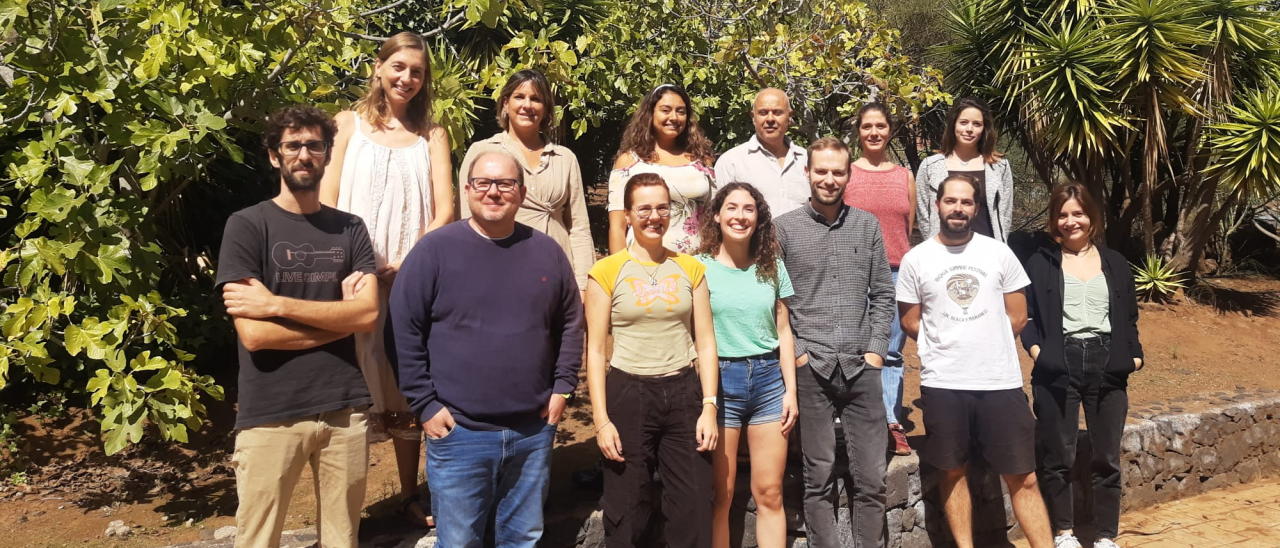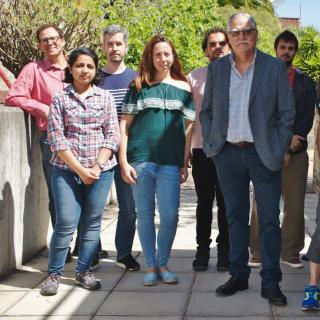Grants related:
General
Welcome to the Traces of Galaxy Formation research group website.
We are a large, diverse, and very active research group aiming to provide a comprehensive picture for the formation of galaxies in the Universe. Rooted in detailed stellar population analysis, we are constantly exploring and developing new tools and ideas to understand how galaxies came to be what we now observe.
A complex star formation history, as the one expected to describe galaxy evolution, needs a multidisciplinary approach to be fully understood. Our group at the IAC consists of experienced researchers in cosmological simulations, dynamical studies, stellar populations and morphological properties of galaxies up to high redshift. We combine different approaches (e.g. observations and theory, secular and cosmological evolution studies) to obtain a complete view of the dominant mechanisms driving the evolution of galaxies.
Within this general framework, we are currently exploring three main areas of research:
- Stellar population synthesis models
- Development of new stellar population synthesis models
- Stellar population analysis tools
- Universality of the stellar initial mass function (IMF)
- Cosmic evolution of galaxies
- Massive galaxy evolution
- Stellar populations in different environments
- Low surface brightness science
- Machine learning and cosmological simulations
- Evolutionary processes in nearby galaxies
- The role of black holes in the evolution of galaxies
- Surveys of nearby galaxies
- Stellar kinematics and dynamical models
If you want to get in contact or work with us, please send an email to the head of the group (Ignacio Martín-Navarro ignacio.martin [at] iac.es (ignacio[dot]martin[at]iac[dot]es)).
Members
Results
Here you can find some of our most recent highlights:
- Local variations of the stellar velocity ellipsoid - II. The effect of the bar in the inner regions of Auriga galaxies. Walo et al. 2022, MNRAS (https://ui.adsabs.harvard.edu/abs/2022MNRAS.513.4587W)
- Anisotropic satellite galaxy quenching modulated by black hole activity. Martín-Navarro et al. 2021, Nature (https://ui.adsabs.harvard.edu/abs/2021Natur.594..187M)
- Evaluating hydrodynamical simulations with green valley galaxies. Angthopo et al. 2021, MNRAS (https://ui.adsabs.harvard.edu/abs/2021MNRAS.502.3685A)
- Sub one per cent mass fractions of young stars in red massive galaxies. Salvador-Rusiñol et al. 2020, Nature Astronomy (https://ui.adsabs.harvard.edu/abs/2020NatAs...4..252S)
- Detection of young stellar populations in apparently quenched low-mass galaxies using red spectral line indices. de Lorenzo-Cáceres et al. 2020, MNRAS (https://ui.adsabs.harvard.edu/abs/2020MNRAS.498.1002D)
Scientific activity
Related publications
-
Census of H II regions in NGC 6754 derived with MUSE: Constraints on the metal mixing scale
We present a study of the H II regions in the galaxy NGC 6754 from a two pointing mosaic comprising 197 637 individual spectra, using integral field spectroscopy recently acquired with the MUSE instrument during its Science Verification program. The data cover the entire galaxy out to ~2 effective radii (re), sampling its morphological structures
Sánchez, S. F. et al.Advertised on:
12015 -
Radial variations in the stellar initial mass function of early-type galaxies
The hypothesis of a universal initial mass function (IMF) - motivated by observations in nearby stellar systems - has been recently challenged by the discovery of a systematic variation of the IMF with the central velocity dispersion, σ, of early-type galaxies (ETGs), towards an excess of low-mass stars in high-σ galaxies. This trend has been
Martín-Navarro, I. et al.Advertised on:
22015 -
Ionized gas kinematics of galaxies in the CALIFA survey. I. Velocity fields, kinematic parameters of the dominant component, and presence of kinematically distinct gaseous systems
Context. Ionized gas kinematics provide important clues to the dynamical structure of galaxies and hold constraints to the processes driving their evolution. Aims: The motivation of this work is to provide an overall characterization of the kinematic behavior of the ionized gas of the galaxies included in the Calar Alto Legacy Integral field Area
García-Lorenzo, B. et al.Advertised on:
12015 -
Overview of the SDSS-IV MaNGA Survey: Mapping nearby Galaxies at Apache Point Observatory
We present an overview of a new integral field spectroscopic survey called MaNGA (Mapping Nearby Galaxies at Apache Point Observatory), one of three core programs in the fourth-generation Sloan Digital Sky Survey (SDSS-IV) that began on 2014 July 1. MaNGA will investigate the internal kinematic structure and composition of gas and stars in an
Bundy, K. et al.Advertised on:
12015 -
The Stellar Initial Mass Function at 0.9 < z < 1.5
We explore the stellar initial mass function (IMF) of a sample of 49 massive quiescent galaxies (MQGs) at 0.9 < z < 1.5. We base our analysis on intermediate resolution spectro-photometric data in the GOODS-N field taken in the near-infrared and optical with the Hubble Space Telescope Wide Field Camera 3 G141 grism and the Survey for High-z
Martín-Navarro, I. et al.Advertised on:
12015 -
Dissecting galactic bulges in space and time - I. The importance of early formation scenarios versus secular evolution
The details of bulge formation via collapse, mergers, secular processes or their interplay remain unresolved. To start answering this question and quantify the importance of distinct mechanisms, we mapped a sample of three galactic bulges using data from the integral field spectrograph WiFeS on the ANU's 2.3-m telescope in Siding Spring Observatory
Seidel, M. K. et al.Advertised on:
12015 -
A Tale of a Rich Cluster at z ~ 0.8 as Seen by the Star Formation Histories of its Early-type Galaxies
We present a detailed stellar population analysis for a sample of 24 early-type galaxies (ETGs) belonging to the rich cluster RX J0152.7-1357 at z = 0.83. We have derived the age, metallicity, abundance pattern, and star formation history (SFH) for each galaxy individually to further characterize this intermediate-z reference cluster. We then study
Ferré-Mateu, A. et al.Advertised on:
122014 -
Stellar Kinematics and Structural Properties of Virgo Cluster Dwarf Early-type Galaxies from the SMAKCED Project. II. The Survey and a Systematic Analysis of Kinematic Anomalies and Asymmetries
We present spatially resolved kinematics and global stellar populations and mass-to-light ratios for a sample of 39 dwarf early-type (dE) galaxies in the Virgo cluster studied as part of the SMAKCED stellar absorption-line spectroscopy and imaging survey. This sample is representative of the early-type population in the Virgo cluster in the
Toloba, E. et al.Advertised on:
122014 -
Nearby supernova host galaxies from the CALIFA Survey. I. Sample, data analysis, and correlation to star-forming regions
We use optical integral field spectroscopy (IFS) of nearby supernova (SN) host galaxies (0.005 2.4 Gyr, respectively) than the massive SN Ia hosts (0.04%, 2.01%, and 97.95% in these intervals). We estimate that the low-mass galaxies produce ten times fewer SNe Ia and three times fewer CC SNe than the high-mass group. Therefore the ratio between the
Galbany, L. et al.Advertised on:
122014 -
SPIDER - X. Environmental effects in central and satellite early-type galaxies through the stellar fossil record
A detailed analysis of how environment affects the star formation history of early-type galaxies (ETGs) is undertaken via high signal-to-noise ratio stacked spectra obtained from a sample of 20 977 ETGs (morphologically selected) from the Sloan Digital Sky Survey-based SPIDER survey. Two major parameters are considered for the study: the central
La Barbera, F. et al.Advertised on:
122014 -
The HST/ACS Coma Cluster Survey - X. Nuclear star clusters in low-mass early-type galaxies: scaling relations
We present scaling relations between structural properties of nuclear star clusters and their host galaxies for a sample of early-type dwarf galaxies observed as part of the Hubble Space Telescope (HST) Advanced Camera for Surveys (ACS) Coma Cluster Survey. We have analysed the light profiles of 200 early-type dwarf galaxies in the magnitude range
den Brok, M. et al.Advertised on:
122014 -
A search for stellar tidal debris of defunct dwarf galaxies around globular clusters in the inner Galactic halo
In the hierarchical formation scenario in which the outer halo of the Milky Way is the result of the continuous accretion of low-mass galaxies, a fraction of the Galactic globular cluster system might have originated in and been accreted with already extinct dwarf galaxies. In this context, we expect that the remnants of these progenitor galaxies
Carballo-Bello, J. A. et al.Advertised on:
122014 -
Stellar population gradients in galaxy discs from the CALIFA survey. The influence of bars
While studies of gas-phase metallicity gradients in disc galaxies are common, very little has been done towards the acquisition of stellar abundance gradients in the same regions. We present here a comparative study of the stellar metallicity and age distributions in a sample of 62 nearly face-on, spiral galaxies with and without bars, using data
Sánchez-Blázquez, P. et al.Advertised on:
102014 -
Intracluster Light at the Frontier: A2744
The ultra-deep multiwavelength Hubble Space Telescope Frontier Fields coverage of the Abell Cluster 2744 is used to derive the stellar population properties of its intracluster light (ICL). The restframe colors of the ICL of this intermediate redshift (z = 0.3064) massive cluster are bluer (g – r = 0.68 ± 0.04; i – J = 0.56 ± 0.01) than those found
Montes, M. et al.Advertised on:
102014 -
CALIFA: a diameter-selected sample for an integral field spectroscopy galaxy survey
We describe and discuss the selection procedure and statistical properties of the galaxy sample used by the Calar Alto Legacy Integral Field Area (CALIFA) survey, a public legacy survey of 600 galaxies using integral field spectroscopy. The CALIFA "mother sample" was selected from the Sloan Digital Sky Survey (SDSS) DR7 photometric catalogue to
Walcher, C. J. et al.Advertised on:
92014 -
Constraining the thick disc formation scenario of the Milky Way
Aims: More than 30 years after its discovery, the thick disc of the Milky Way is not fully explored. We examine the shape of the thick disc in order to gain insight into the process of its formation. Methods: The shape of the thick disc is studied in detail using photometric data at high and intermediate latitudes from SDSS and 2MASS surveys. We
Robin, A. C. et al.Advertised on:
92014 -
The effect of the environment on the stellar mass-size relationship for present-day galaxies
In order to study how the environment can influence the relationship between the stellar mass and effective radius for nearby galaxies (z < 0.12), we use a mass-complete sample extracted from the NYU-Value Added Galaxy Catalogue. This sample contains almost 232 000 objects with masses of up to 3 × 1011 M⊙. For every galaxy in our sample, we explore
Cebrián, M. et al.Advertised on:
102014 -
Constraints on the merging channel of massive galaxies since z ˜ 1
We probe the merging channel of massive galaxies over the z = 0.3-1.3 redshift window by studying close pairs in a sample of 238 galaxies with stellar mass ≳1011 M⊙, from the SHARDS (Survey for High-z Absorption Red and Dead Sources) survey. SHARDS provides medium-band photometry equivalent to low-resolution optical spectra (R ˜ 50), allowing us to
Ferreras, I. et al.Advertised on:
102014 -
The Mice at play in the CALIFA survey. A case study of a gas-rich major merger between first passage and coalescence
We present optical integral field spectroscopy (IFS) observations of the Mice, a major merger between two massive (≳1011 M⊙) gas-rich spirals NGC 4676A and B, observed between first passage and final coalescence. The spectra provide stellar and gas kinematics, ionised gas properties, and stellar population diagnostics, over the full optical extent
Wild, V. et al.Advertised on:
72014 -
Kinematic alignment of non-interacting CALIFA galaxies. Quantifying the impact of bars on stellar and ionised gas velocity field orientations
We present 80 stellar and ionised gas velocity maps from the Calar Alto Legacy Integral Field Area (CALIFA) survey in order to characterise the kinematic orientation of non-interacting galaxies. The study of galaxies in isolation is a key step towards understanding how fast-external processes, such as major mergers, affect kinematic properties in
Barrera-Ballesteros, J. K. et al.Advertised on:
82014


